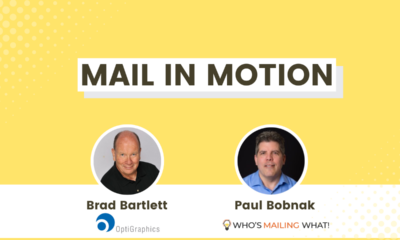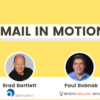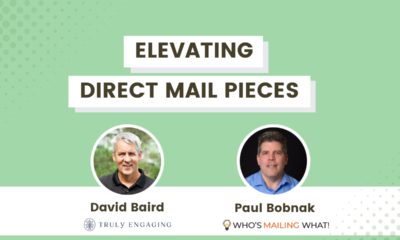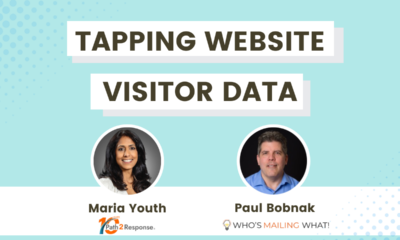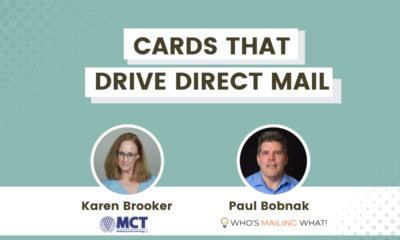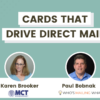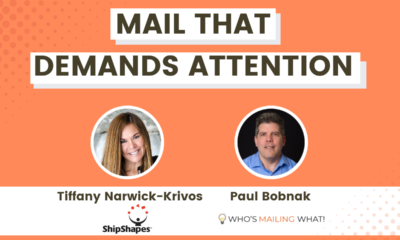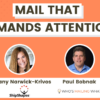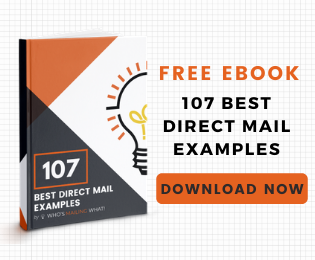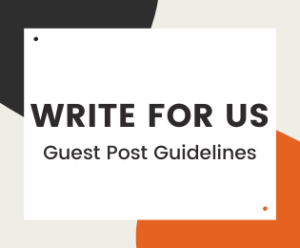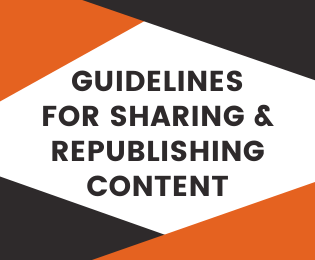MEET THE MAILERS
Meet the Mailers: Nonprofit Fundraising Direct Mail
In this episode, I talked with Altus Marketing about how the company works with non-profit organizations to reach audiences with direct mail.
In this episode, I talked with Andrew Olsen, CFRE, President of Altus Marketing, about how the company works with non-profit organizations to reach audiences with direct mail.
Altus provides integrated fundraising solutions for non-profit, ministry, and membership organizations.
Our discussion covered a wide range of issues in non-profit fundraising with direct mail. For example, on targeting contributors in different places and ways on the donor journey:
There’s an opportunity … because of how data and digital presses have evolved to be able to take one donor file, one audience, and identify traits within, and to deliver a different experience in a more cost-effective way to multiple different audiences.
 Andrew OlsenPresident
Andrew OlsenPresident
Altus Marketing
Among the topics we covered:
- Andrew’s background in direct mail and role as President
- Best way to inspire giving
- Tactics for donor retention
- Supply chain issues – how to deal with them
- Trends in direct mail fundraising
- Best value proposition for mail
Here are some questions and answers (edited for clarity and space):
- What’s the best way for non-profits to inspire donors and members using their direct mail?
I would say that the most important piece there is to tell a great story. And what that means is that the organization needs to essentially take themselves outta the equation and let the donor be the hero in the story, and share what it means for the donor to make a gift and how that gift makes an impact in some life-changing way, either for the person that they serve, the animal that they’re going to rescue, the environment, whatever their cause is.
But painting that picture in a very emotional way for the donor to understand that by taking an action and writing a check, making a credit card gift, giving a gift from their donor advise fund, whatever it is that is the conduit through which they’re gonna make some sort of transformational change in the world.
But you know, someone will say things like, “well, we need to educate our donors” or “we really think if you put more statistics in there, people will just get it more and they’ll give”, and that is never the case …
Donors make a giving decision based on pulling their heartstrings. They decide how many zeros go on the check by marrying that with some logic.“Is this an efficient organization?”, “Are they effective?”, “Can I trust them?” – those kinds of things. But the decision to give in the first place always comes down to “Did it compel me emotionally?”
- [W]e know that a lot of non-profits have challenges retaining donors … What tactics or messaging should they be using in direct mail to keep donors around longer?
I think the first thing I would say there is that process actually starts as you’re planning acquisition. So what we find more and more these days is that organizations that are driving for upfront response rate or upfront average gift, rather than looking at long-term retention and long-term value, as the key indicators in acquisition performance, tend to have bigger problems with donor churn.
[A]s you look at your acquisition strategy, plan your list mix and your audience mix based on what the long-term value is that you’re looking to achieve. Then from there, move into what’s the journey that you want to take this donor on once they make a gift, so what are all the disparate experiences that a donor might have with your organization and how do you tie them together in a way that makes the donor feel like they’re part of a really thoughtful and engaging experience and that you are triggering the emotional needs that they have about philanthropy and then, on a regular basis, paying that off through storytelling and positioning your proof points and all those kind of things.- A lot of non-profits use RFM analysis to drive their segmentation and their targeting. So briefly, first of all, what is RFM, and is this always the best approach?
Yeah, so that’s funny. I was just talking with a gentleman a couple days ago who’s a really high-level direct response analyst. And we were having the same conversation, you know, RFM: recency, frequency, and monetary.
So how recent was your last gift? How frequent have you given to the organization? And typically what’s the largest single gift that you’ve given? So that’s typically how organizations approach RFM at its core.
I mean, RFM is a very simple model, right? And 9 times out of 10 for most organizations, RFM is sufficient for an average campaign.
However, with the increasing costs that we’re all experiencing because of supply chain challenges, labor shortages, and other things like that, and the need for organizations to keep up with inflation in their revenue, kind of all coming together at the same time, we’re counseling our clients to rethink this and RFM is not going away. You shouldn’t just throw it out the window, but there are certainly additional tools that you can bring to bear on top of RFM or, in some cases, instead of, that get you an enhanced level of performance, right?
[I]f your organization is not modeling your audience to also look at long-term value to incorporate, say, potentially wealth data or external consumer behavior data, or data about how the donor might give to other charities that they support. Those can all create added value in your segmentation strategy and help drive greater net revenue for organizations.- [P]ostage and paper costs have put a lot of pressure on non-profits to save money on mail. So what are some good ways to keep costs under control?
The supply chain issues are just messy right now. I mean, whether it’s postage or paper or recently until the strike was ended overseas, it was, you know, address labels, any number of things. This is gonna be the reality for us for at least the next 12, maybe 24 months.
And so a couple of things that organizations should be doing.
First of all, plan ahead. So one of the things that I would hear from clients all the time is “your lead times are too long” – and that was years ago. Whereas today we’re saying “add another 12 to 18 weeks to your lead time so that you can make sure that you’re locking in inventory”. So that’s one.
I think working with your vendor partners to make sure that if you typically mail uncommon formats or, you know, certain types of paper or envelopes that are either harder to come by or more expensive, rethink that because the lift you get out of those uncommon formats and different papers and things like that may not be worth the risk of not being able to source them over the next two years. Or paying a 50% markup on the original cost. So you’ve gotta measure it against that.
I would say also, for example, if you’re a premium mailer, if you mail labels, if you mail notepads or something like that, do you need as much of them in your mail as you used to? So if you typically have two label sheets, could you do with a quarter sheet right now? Could you do with one sheet? If you typically mail a 12-sheet notepad, could you get away with six-sheet and not have a meaningful decrease in response?
I would also say now is the perfect time to be testing bouncebacks and other mission-related content that might help you get out of a premium track and actually get a higher value donor and more net revenue as a result because you’re forced to today.
So that would be one thing.
Two is your segmentation strategy. So what we’re looking at with a lot of our clients is it no longer makes sense to mail certain really low-value, low-frequency donors, whereas a year ago, maybe it was okay, maybe you got enough net or you reactivated enough names to make it make sense.
Today, we’re looking at that and modeling those audiences and saying, “Well, wait a minute, if I can take the third lowest-performing segment and shift that budget to connected TV or display or search or any other channel where I don’t have the same resource constraints, I can actually get a lot more value out of that for an organization versus just mailing everybody”.
[W]e’re even starting to test particularly for audiences where, let’s say you’ve got a segment of people on your file who always respond online.It doesn’t necessarily make sense to not mail them anymore because oftentimes the mailing is what triggers the online gift behavior, and we’ve tracked and measured that like a lot of organizations have, but you know, the question is, can I mail them something cheaper? Can I mail them an oversized postcard? Can I send them a self-mailer? What are the different lower-cost tactics, less paper that we can put in the mail and still trigger our response, but not have the same risk on our portfolio?
- What kind of trends do you see unfolding in direct mail for the rest of this year and going into next year?
Now it might muddy your attribution and your direct mail may not get all the credit. But your overall revenue lifts. So I think that’s a really big trend that’s not gonna go away.
I think a lot of organizations, because of the supply chain pressures and the cost pressures, are smartly gonna start looking and saying, “Well, wait a minute, where do we shift our investments? Are there places we maybe hadn’t looked before that we should?”
So for example, a lot more organizations are saying, “well, wait a minute, we’ve always talked about launching a sustainer program, now we have to” or “we’ve always talked about launching a major donor program. We’ve never done it because we’ve never felt like we needed to because direct mail was just pouring cash in the door, but now we have to because of these pressures”. So I think we’re gonna see more and more of that as a trend.
And then I think, because again of what’s going on with the availability and reduced cost of data, and the ability to create variable messaging and creative through digital presses, one of the things that we’re seeing a lot more is a desire and an openness to really kind of micro-target and hyper-target audiences with different messaging, different creative, different value propositions and offers even within the same campaign effectively. And looking at that as a way to create a meaningful improvement in the donor experience and drive revenue increases through it.
Here is our conversation. We’ve added timecodes for your convenience.
Thanks again, Andrew, for an interesting and informative chat! To learn more about Altus Marketing, visit AltusMktg.com.
Your comments and ideas are very important to us in making your Who’s Mailing What! experience even better for you. Through these engaging and helpful talks, we hope you’ll take away practical tips, insights, and stories to inspire and build your own success.
If you have any feedback — or are interested in sharing your expertise and viewpoint with our wide and diverse audience on “Meet the Mailers” — please reach out to me. I’d love to hear from you!







